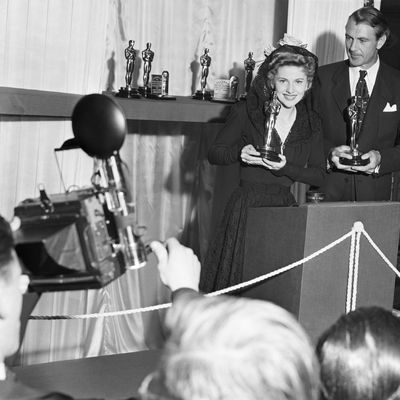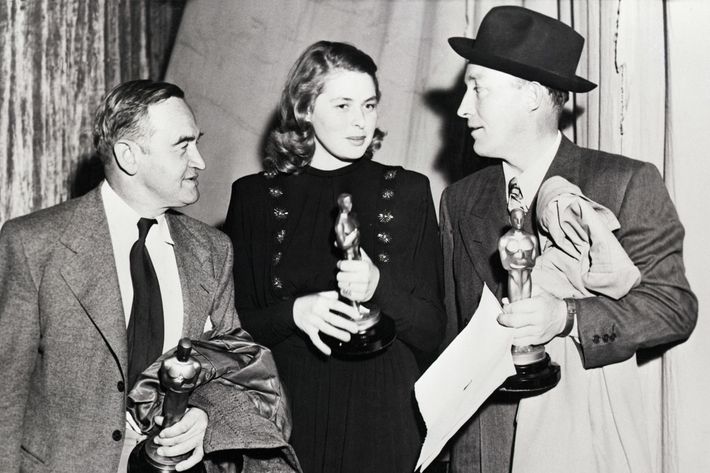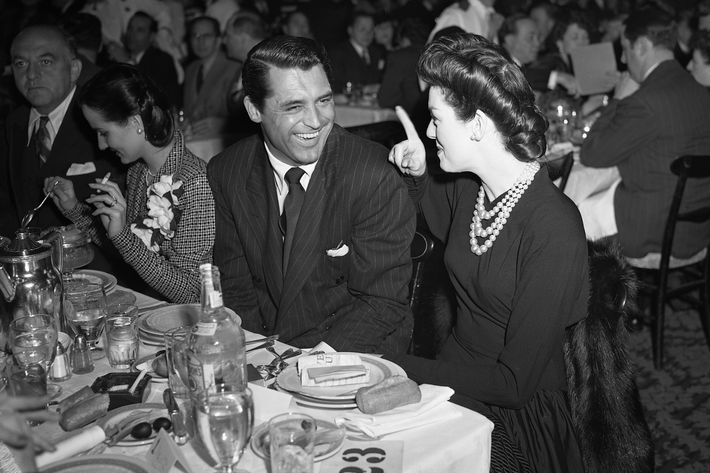
Between the megawatt stage and diamond-encrusted gowns, the Oscars are all about glamour. The awards show features Hollywood at its showiest, shiniest peak — an opportunity for viewers at home to marvel at all the beautiful people and applaud their success.
But for a few strange years, the Oscars had to reinvent this glittering image. The outbreak of World War II made it impossible to keep projecting the Hollywood dream without the appropriate gestures to wartime reality, placing the Academy in an awkward situation: How could it honor a bunch of movie stars without looking hopelessly tacky? The answer, from 1942 through 1945, was a sort of anti–Academy Awards, where celebrities were expected to dress conservatively, specially invited speakers rallied for the Allies, and no one walked home with (literal) gold.
The Oscars, like much of America, were largely untouched by the war prior to Pearl Harbor. But there were previews of the coming changes at the 1941 ceremony, when President Franklin Roosevelt addressed the crowd in a six-minute speech relayed via radio from the White House. “In these days of anxiety and world peril, our hearts and minds and all of our energies are directed toward one objective,” he told the Oscar attendees. “That objective is the strengthening of our national defense … Tonight, I want to place the chief emphasis on the service that you can render in promoting solidarity among all the peoples of the Americas.”
Roughly seven months later, the bombs hit Pearl Harbor and the U.S. formally entered World War II. These developments left the Academy of Motion Picture Arts and Sciences scrambling. Academy leaders worried that hosting a glitzy party as the country prepared for wartime rations would send the wrong message. The board of governors initially voted to cancel the Oscars altogether, a decision it announced in a statement to the press in late December 1941.
But Bette Davis thought there was a way to reconfigure the Academy Awards to suit the new national mood. Davis, who was then Academy president, suggested moving the show from a banquet hall to an auditorium and allowing the public to buy tickets. All proceeds would go to the Red Cross. Davis’s plan was ultimately rejected, but the board of governors decided to resurrect the ceremony under new conditions. It would now be an informal dinner, with the dress code to match. Men were expected to wear more casual suits instead of tuxedos, but military dress was even better — provided they had enlisted. Women would also have to leave their extravagant designer gowns at home, opting for more sensible dresses and shoes. There would be no dancing after the dinner, and the usual searchlights outside the Biltmore Hotel would be scrapped. The changes were pithily summarized in a Variety headline announcing the new plan: “Will Hold Academy Dinner After All, But Nix Finery, Hoofing and Glitter.”

The shift in tone was immediately apparent when the guests arrived on February 26, 1942. Jimmy Stewart, who had accepted an Oscar the previous year in a black tux, entered the hotel in his Air Force uniform. Joan Fontaine, the eventual Best Actress winner for Suspicion, looked like a chic widow in mourning in her dark, long-sleeved dress and lacy veil. But the celebrities weren’t just dressing the part. They also ceded their platform to Wendell L. Willkie, an unofficial envoy for Roosevelt and failed 1940 presidential candidate. Willkie served as the principal speaker for the evening, and he used his time to significantly amp up his boss’s rhetoric from the last ceremony. While Willkie acknowledged that the industry had “been alert to the requirements of the hour,” he urged Hollywood to “take offensive against the Axis,” and “begin to act in terms of striking, not blocking.” “You understand that this is truly a total war,” Willkie dramatically intoned.
Willkie didn’t need to worry; Hollywood had definitely gotten the memo. The wartime touches only became more visible as the international conflict dragged on and the industry became further involved in the war efforts. At the 1943 ceremony, the Academy commissioned the operatic musical star Jeanette MacDonald to sing the national anthem. Winners accepted their awards against a dramatic backdrop, too — a banner with the number “27,677” blown up and studded with stars, representing the tally of industry players serving in the war. The 1944 ceremony would be transmitted over the radio to United Nations troops from Grauman’s Chinese Theatre, where many uniformed men and women filled the space as invited guests. (As this clip shows, some of them were seated right on the stage.)
The WWII effect extended well beyond the decorations and guest list. Between 1942 and 1945, the Oscars routinely rewarded patriotic movies that saw ordinary people making extraordinary sacrifices for the Allied victory, most notably Best Picture winners Mrs. Miniver and Casablanca. The rah-rah atmosphere also infiltrated the acceptance speeches, historically short and impersonal affairs that were now veering into political territory. In her 1943 Best Actress acceptance speech for Mrs. Miniver, Greer Garson told her peers that “praise from our government and our armed forces and from abroad from our allies for work we have done should make us determined to carry on.”

Katina Paxinou, the 1944 Best Supporting Actress winner for For Whom the Bell Tolls, made a more direct address to the troops listening on the radio: “I would like to thank also the voters and the committee of the Academy Award for giving me, besides this honor, the opportunity to send through the air my deep love and admiration to the heroic boys, to the heroic soldiers of your great nation, the American boys who are fighting with their allies all over the world for liberty, justice, and human dignity.”
But perhaps the most remarkable sign of wartime austerity was in the Oscars themselves. Due to metal shortages, the Academy was forced to choose new materials for its statuettes. While the Oscars were traditionally cast in bronze and finished with gold plating, the ones handed out in 1943, 1944, and 1945 were made of plaster and sprayed with a bronze lacquer in a process that the New York Times called “a $12 job made to look like the old $90 thing.” Winners were assured that they could swap their plaster Oscars for the shinier, more expensive version once the war was over, but at least one recipient broke his statuette in the meantime.
After the war ended, the Academy stopped putting on an informal army recruitment ad and went back to its glamorous roots. The men hung up their dress blues for tuxedos, while the women returned to formal gowns with brighter colors, lower necklines, and shorter sleeves. It was as if the pivot to patriotism had never happened, though Hollywood wasn’t able to shake the war out of its system that easily. Just a year later, William Wyler’s The Best Years of Our Lives brought the lingering effects of World War II to the forefront with its portrayal of three soldiers struggling to return to home life. The movie won an astonishing eight Academy Awards, including two for actor Harold Russell, the real-life veteran who earned both a competitive Best Supporting Actor award and a special Oscar for “bringing hope and courage to his fellow veterans.” Both of his statuettes were plated in gold.

